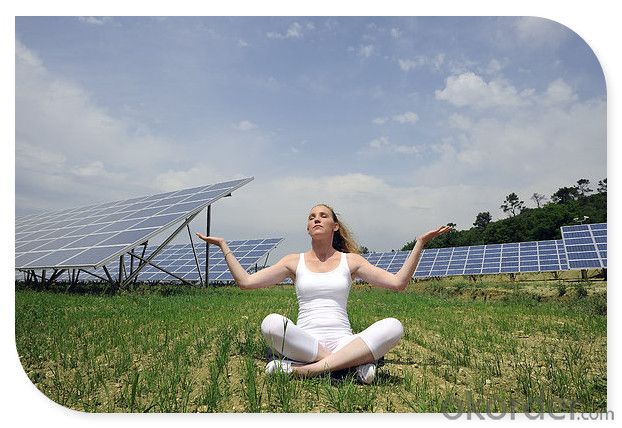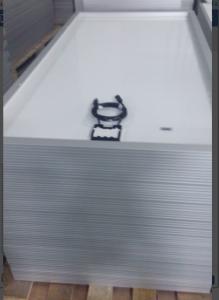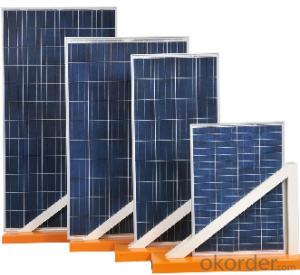Washington Solar Panels:270w Direct Factory Sale Price 260-300watt Solar Panels
- Loading Port:
- China main port
- Payment Terms:
- TT OR LC
- Min Order Qty:
- 10000 watt
- Supply Capability:
- 100000 watt/month
OKorder Service Pledge
OKorder Financial Service
You Might Also Like
Specification



Solar Module Introduction
Solar modules use light energy (photons) from the sun to generate electricity through the photovoltaic effect. The majority of modules use wafer-based crystalline silicon cells or thin-film cells based on cadmium telluride or silicon. The structural (load carrying) member of a module can either be the top layer or the back layer. Cells must also be protected from mechanical damage and moisture. Most solar modules are rigid, but semi-flexible ones are available, based on thin-film cells. These early solar modules were first used in space in 1958.
Electrical connections are made in series to achieve a desired output voltage and/or in parallel to provide a desired current capability. The conducting wires that take the current off the modules may contain silver, copper or other non-magnetic conductive transition metals. The cells must be connected electrically to one another and to the rest of the system. Externally, popular terrestrial usage photovoltaic modules use MC3 (older) or MC4 connectors to facilitate easy weatherproof connections to the rest of the system.
Specification
Model Type | |
Peak Power-Pmax(W) | 5-200W |
Open Circuit Voltage-Voc(V) | 44.2 |
Maximum Power Voltage-Vmp(V) | 36 |
Short Circuit Current-Isc(A) | 5.4 |
Maximum Power Current-Imp(A) | 5 |
Maximum System Voltage | 1000V DC |
Maximum Series Fuse Rating | 10A |
Power Tolerance | -1~+3% |
Temperature Coefficients of Pmax | -0.45%/℃ |
Temperature Coefficients of Voc | -0.348%/℃ |
Temperature Coefficients of Isc | 0.031%/℃ |
Nominal Operating Cell Temperature | 44.5±2℃ |
Standard Testing Condition(STC) | Irradiance:1000W/m²;Temperature:25℃;AM=1.5 |
Qualification Test Parameters | |
Operating Temperature | -40℃~+85℃ |
Storage Temperature | -40℃~+85℃ |
Pressure Bearing | ≥5400Pascal/m² |
Wind Bearing | ≥5400Pascal/m² |
Mechanical Characteristics | |
Cell Size | Mono 125*125mm±0.5 |
No.of Cells | 72pcs(6*12) |
Dimension | 1580*808*40mm |
Weight | 15.5Kg |
Glass | 3.2mm High Transmission,Low Iron |
Frame | Anodized Aluminum Alloy |
Junction Box | IP65Rated |
Internal Diodes | 3 Bypass Diodes |
Cable | 1*4.0mm² Length 900mm |
Images
Packing & Shipping:
We have rich experience on how to pack the panels to make sure the safety on shipment when it arrives at the destination.
The normal size is packed by 25pcs/ carton / pallet. Paper carton for FCL shipping and wood carton for LCL shipping.
Features
1.High reliability with guaranteed -3% to +5% power output tolerance, ensuring return on investment
2.High conversion efficiency based on leading innovative photovoltaic technologies
3.Withstands high wind-pressure and snow load, and extreme temperature variations
4.Attractive appearanceUnique frame design, high mechanical strength, and easy Installation
Warranty:
For c-Si panel: 25years output warranty for no less than 80% of performance, 10 years output warranty for no less than 90% of performance. Free from material and workmanship defects within 5 years.
For a-Si panel: 20 years output warranty for no less than 80% of performance, 10 years output warranty for no less than 90% of performance. Free from material and workmanship defects within 2 years.
•100% product quality protection
•100% on-time shipment protection
•100% payment protection for your covered amount
FAQ:
(1)What price for each watt?
It depends on the quantity, delivery date and payment terms.
(2)What is your size for each module? Can you tell me the Parameter of your module?
We have different series of panels in different output, both c-Si and a-Si. Please take the specification sheet for your reference.
(3)Can you provide the peripheral products of the solar panels, such as the battery, controller, and inverter? If so, can you tell me how do they match each other?
Actually we are only manufacturer of solar panels, but we could try to source them for you in China if you need. We could provide you an optimal system design to instruct you how to install.
(4)Do you have the CE, TUV, UL Certification?
We’ve already passed all the tests, and any certificate is available.
(5)Have you ever sold your products to companies in my country?
Of course, we have customers in all general PV markets, but I think we should expand our market share along with the market growth.
(6)When did your company set up? You are a new company, how can I believe your quality?
We entered into Solar PV industry in 2005, now we have several plants in manufacturing of a-Si and c-Si panels, and our capacity is 220MW per year. Till now we have already passed all the tests by authorized laboratories, e.g. TUV, VDE, UL.
(7)Can you help us install the module if we cooperate with you?
We haven’t entered into installation sector, but we have the plan in near future.
(8) How do you pack your products?
We have rich experience on how to pack the panels to make sure the safety on shipment when it arrives at the destination.
(9) Can you do OEM for us?
Yes, we can.
(10)Can we visit your factory?
Surely, I will arrange the trip basing on your business schedule.
- Q: I'm a carpenter, and can do electric work. I want to make some money installing Solar Panels. what's the best source?
- DRI Roofing. They are coming out with some of the best technology for solar panels. I know they have a different branch for the solar panel division, but i don't remember it right now.
- Q: . The 2v battery will only be turning a small 2v motor that will be turning very slowly yet possibly or a long time. 2. -2 hours max per day it will be running3. I want it to be fully sufficient on solar power once the energy in the battery runs out. What specifications for my panel do you think I will need. However, i have limited space so the smaller the better as long as it can do the jobP.S: I don't know much about electricity and solar power so simple answers please :)
- Are you concerned about your higher energy bills? What about the atmosphere, are you worried about its resources that are nonrenewable? Solar energy and how to make solar panel are the solutions for you. Let us talk about the charges of pv strength and how practical it is for YOUR budget. The first thing you should know is that the size of your house has nothing to do with the cost on how to make solar panel. So for those people fortunate sufficient to are living in a gigantic property, pv panels are not here to overwhelm you with charges. What you do need to consider into consideration are items like how much sun you get a day, in which you stay, and how very much power you use a day. After you can appear to individuals conclusions, we can commence the math. Permit us do an instance together to figure out a ballpark expense for pv panels. Take a peak at your power bill as it is now and locate how numerous KWH you used, We will say that variety you found was 800 KWH. Now we are going to divide 800 by 30 and we get a whopping 26. 7. Don’t forget that quantity. It is how very much estimated KWH you use a evening. If you locate that you are exposed to six hours of sunlight a morning you would then consider the 26. 7 and divide it by 6. You reply should be four. 45 (or 4,450 watts). If you multiply that reply times . 5 you have successfully observed out how a lot of photo voltaic panel watts you need. The installation costs then are associated to the quantity you found above. Each and every watt usually costs $7-$9. All your installation fees need to be integrated with that estimated ending price. Now that you know how very much your method will charge, you will be relieved to know that it actually pays for itself inside six many years. There are also tax exemptions for people that select to use pv vitality. It is an investment that is really worth anyone’s time and funds Hope It's Help.
- Q: Can solar panels be installed on theme parks or amusement parks?
- Yes, solar panels can be installed on theme parks or amusement parks. In fact, many amusement parks around the world are increasingly adopting solar energy to power their operations. Solar panels can be installed on rooftops, parking lots, or even integrated into the design of rides and attractions. This helps to reduce the parks' carbon footprint, lower energy costs, and promote sustainability in the entertainment industry.
- Q: I live in Sacramento, CA, and I need some solar panels for a project fo school. They don't have to be very big......just something that I can use as an example.Thanks!
- Trees, they have plenty of leaves. You'll probably have to buy an educational kit from Radio Shack or something like that. Maybe break some old solar powered calculators open.
- Q: Can solar panels be installed on farmlands or agricultural fields?
- Yes, solar panels can be installed on farmlands or agricultural fields. In fact, solar farms have become increasingly common in these areas due to their dual purpose of generating renewable energy while allowing for continued agricultural use of the land. This practice is known as agrivoltaics or solar farming, and it provides an opportunity for farmers to diversify their income by leasing or owning the land for solar power generation. Additionally, the shade provided by solar panels can benefit certain crops, leading to increased yields and reduced water usage.
- Q: what direction should solar panels face to get the best exposure of the sun.
- Not compass south, but solar south. It's easy to find. Google Find Solar south and you can get directions. Even better are trackers, that will let your panels track the sun all day.
- Q: 260 watt solar panels on an rv?
- It depends on the power you need. There should be a controller between the battery and the solar pv panels.
- Q: How do solar panels withstand harsh weather conditions?
- Solar panels are designed to withstand harsh weather conditions through their durable construction and protective materials. They are typically made with tempered glass or other strong materials that can withstand hail, snow, and heavy rain. Additionally, they are designed to be water-resistant and have proper drainage systems to prevent water damage. Moreover, solar panels go through rigorous testing and certification processes to ensure they can withstand extreme temperatures, high winds, and other environmental factors.
- Q: Can solar panels be damaged by hail or other elements?
- Yes, solar panels can be damaged by hail or other elements. Hailstones, strong winds, and other extreme weather conditions can potentially cause physical damage to solar panels, such as cracks in the glass surface or dislodging of components. However, most solar panels are designed and tested to withstand such elements to a certain extent, and reputable manufacturers often provide warranties to cover any damages caused by hail or other weather-related incidents.
- Q: I am looking at building my own solar panels to at least help cut down the rising energy bill. I know its expensive. I already have the solar cells so no need to worry about listing that. But i am looking at wiring it directly into the house. Is there any parts that you could list for me, that would be great. thanks
- Most okorder / . If you had an array of 0 or more panels, it would usually be cheaper to get a single, large inverter. The usual path taken with homemade panels seems to be using them to charge a battery, then running things of the battery. And it's usually a fun thing to do, but not a way to save money. Just so you know.
Send your message to us
Washington Solar Panels:270w Direct Factory Sale Price 260-300watt Solar Panels
- Loading Port:
- China main port
- Payment Terms:
- TT OR LC
- Min Order Qty:
- 10000 watt
- Supply Capability:
- 100000 watt/month
OKorder Service Pledge
OKorder Financial Service
Similar products
Hot products
Hot Searches




























